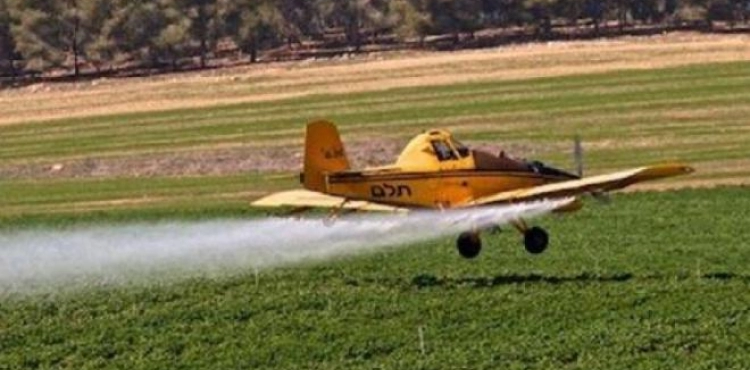On Wednesday, Israeli warplanes continued to spray chemical pesticides in the areas near the eastern fence separating the eastern Gaza Strip, which they had sprayed on Tuesday morning for about three and a half hours, leading to their destruction .
The Al-Mezan Center for Human Rights and the "Gisha-Maslak" Center said in a joint statement: The spraying operations affected agricultural lands in the eastern regions extending from the northeast of Al-Bureij in the Al-Wusta Governorate, and the eastern Gaza Governorate, and the east of Beit Hanoun in the North Gaza Governorate.
According to eye-witnesses of the farmers whose spraying operations coincided with their presence to work on their agricultural lands near the eastern separation fence, the occupation forces set fire at 7:20 this same morning, a black smoke on the Israeli side east of the separation fence to know the direction of the wind, which is A process that the occupation forces always perform and precedes spraying, according to the farmers - and after several minutes, a plane began flying over the separation fence and sprayed chemical pesticides, whose spray was spread toward the Palestinian farmers´ lands on the western side of the fence, and then began spraying operations in Area A Located north-east of Bureij in the central province, sending then to the east of Beit Hanoun town in the northern Gaza Strip. Spraying operations continued until 11:30 in the morning.
It also expanded the spraying area in the central governorate to the east of the city of Deir al-Balah, and spraying operations continued until 11:00 am on the same Wednesday. It should be noted that the spraying operations take place suddenly and without warning or advance warning, and they are mostly on the Israeli side of the eastern separation fence, and sometimes they carry out spraying operations inside the territory of the Strip, and before the spraying operations, the occupation forces make sure that the direction of the wind is towards the territory of the Strip West of the separation fence.
The aircraft also fly at low altitudes, which may reach a level of 20 meters above the ground, and the spraying of pesticides reaches a depth ranging between (700-1200) meters inside the lands of the Gaza Strip. Spraying operations are repeated during two periods annually (the end of December or the beginning of January - and the month of April), which is the beginning of growing winter and summer crops. Palestinian farmers incur huge losses as a result of these practices, through the spraying processes left behind by the crops, and they make farmers hesitate or refrain from cultivating their lands in those areas, given the seriousness of the area, and the potential for damage to their crops in the event of access to air spraying materials.
The monitoring and documentation processes that “Al-Mizan Center” and “Peshah-Maslak” are monitoring indicate that the occupation forces started spraying operations since 2014. And that the damage resulting from the spraying operations affected (7620000) square meters of agricultural land in the Gaza Strip In this context, the London-based research agency, Forensic Architecture (Forensic Evidence Structure) published, in July of 2019, a new report providing an analysis of the aerial spraying of herbicides carried out by Israel between 2014 and 2018.
The report relies heavily on field research and information published in the framework of legal efforts carried out by human rights institutions, "Pisha-Maslak", the Al-Mezan Center for Human Rights and the Adalah Center for years. The research supports the conclusions of the associations, and it is recognized that spraying operations have caused extensive damage to fields and crops within the territory of the sector, while the Israeli Ministry of the Army revealed in 2016 that the materials used in aerial spraying are: Glyphosate, Oxygal and Durex.












